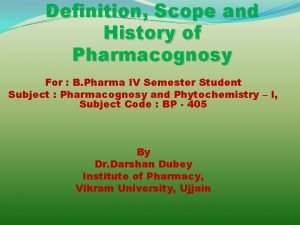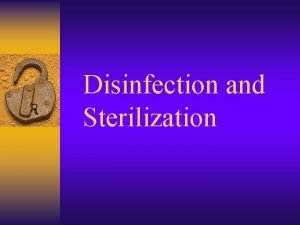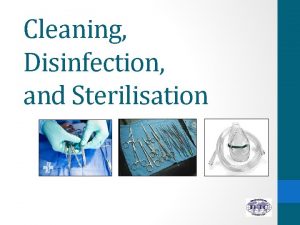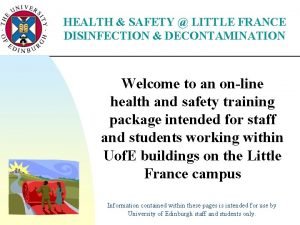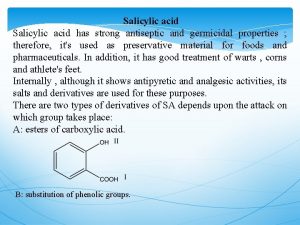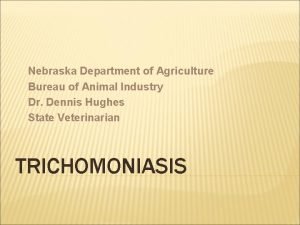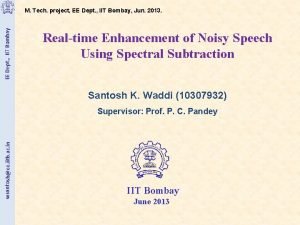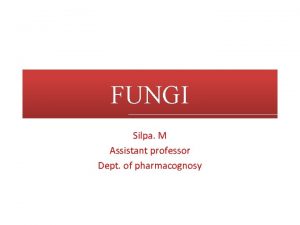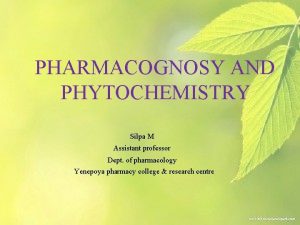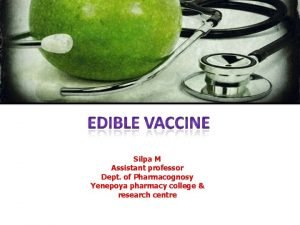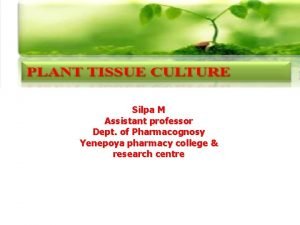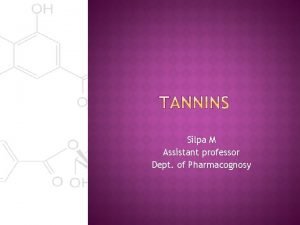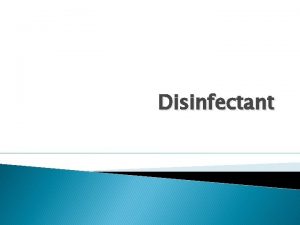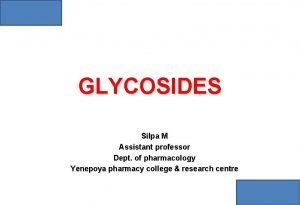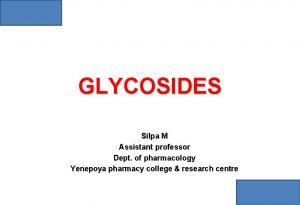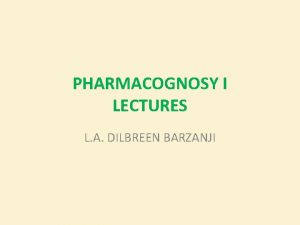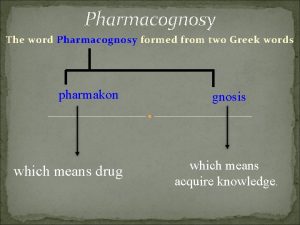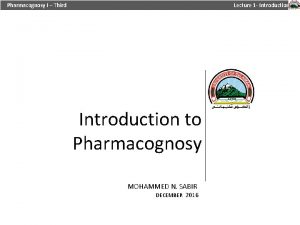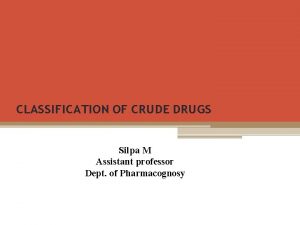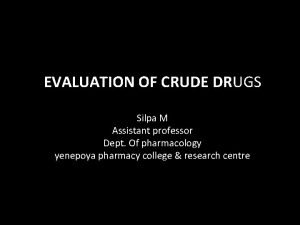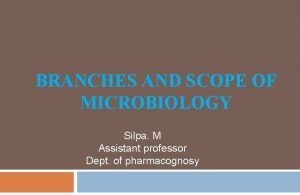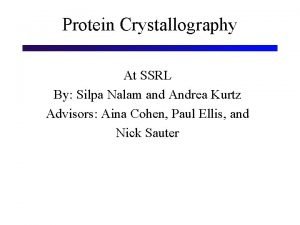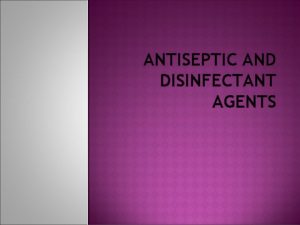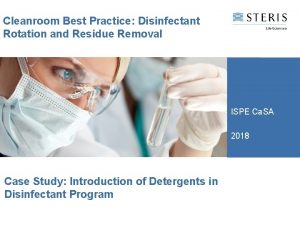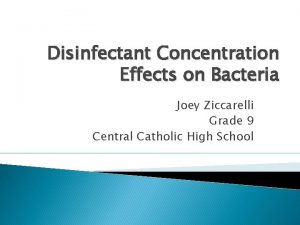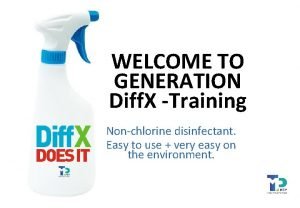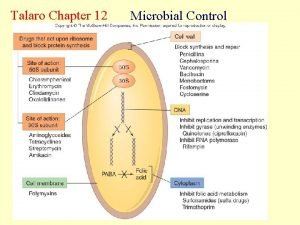DISINFECTANT Silpa M Assistant professor Dept of pharmacognosy




























- Slides: 28

DISINFECTANT Silpa. M Assistant professor Dept. of pharmacognosy

Disinfection ü Destruction of microorganisms, but not usually spores: not necessarily killing all microorganisms but reducing them to a level of not harmful to human health. ü Hence disinfectants are applied to inanimate objects.

Disinfectant ü It is an agent used for the destruction of the organisms on the inanimate objects. They have bactericidal action.

Commercially Available Disinfectants And Their Applications sl. no Enzyme Application(s) 01 Dettol Anti-infective 02 Lysol Floor Cleaning 03 Phenol Gargles, mouth washes 04 Chlorxylenol Active against staptococci 05 Chlorhexidine Skin disinfectant

Classification of disinfectants 1. Based on consistency (a) Liquid (E. g. , Alcohols, Phenols) (b) Gaseous (Formaldehyde vapour) 2. Based on spectrum of activity (a) High level (b) Intermediate level (c) Low level

3. Based on mechanism of action (a) Action on membrane (E. g. , Alcohol, detergent) (b) Denaturation of cellular proteins (E. g. , Alcohol, Phenol) (c) Oxidation of essential sulphydryl groups of enzymes (E. g. , H 2 O 2, Halogens) (d) Alkylation of amino-, carboxyl- and hydroxyl group (E. g. , Formaldehyde) (e) Damage to nucleic acids (Formaldehyde)

Mechanism of action of disinfectants DISINFECTANT MECHANISM OF ACTION Phenol Low conc. - Disrupt cytoplasmic membrane. – leakage of cellular constituents High conc. - Act as protoplasmic poison Alcohols Denature the protein – 60 -90% best active. Aldehydes Combine with amino group of protein Dyes Inactivate bacteria by reacting with acidic group of cell. Inhibit glutamine synthesis. Inhibit cell wall systhesis. Surface +vely charged Quart. amm. comp strongly active agents absorbed on the –velty charged bacterial surface. – damage cell membrane – leakage…

DISINFECTANT MECHANISM OF ACTION Halogens Halogenate or oxidize the vital cell wall components. Metals Hg, Ag, Cu – protein precipitants. Toxic part react with enzyme and affects the protein structure Guanidines & amidines Disrupt cell wall followed by destruction. Furan derivatives Inhibits H 2 and electron transport chain (uncertain). Quinolines and isoquinolines Form a complex with iron , copper to form toxic complex.

• Evaluation of Bacteriostatic disinfectant – Serial dilution in liquid media – Serial dilution in solid media – Fish Spine bead method – Cylinder plate method – Filter paper disc method – Cup and Plate method – Gradient Plate technique – Ditch Plate method

• SERIAL DILUTION METHOD IN FLUID MEDIUM • Different concentration of the disinfectants are prepared (gradient concentration of the disinfectant are added to nutrient medium) • The tubes are labeled and to each of the test tube known organisms are inoculated and incubate for 48 hr at a specific temperature. • The growth is observed by minimum inhibitory concentration by turbidometric method or by UV spectrophotometric method.

• Media + 0. 2 ml of Culture + Test DI Dilution control I st Dil 2 nd Dil 3 rd Dil 4 th Dil 5 th Dil

• SERIAL DILUTION METHOD ON SOLID MEDIUM • • Double strength agar medium is prepared Mixed with equal volume of disinfectant and sterilize. Pour it into petri dish and allow to solidify. Keep it at 37 o. C for 1 day so that if any contamination, it will be enlighten. If not the plates are transparent, clear with clean surface. • Organisms are streaked over the agar / on the surface and incubate it for 3 days then observe for the growth. • Note: Different plates are used for different concentration of the disinfectants.

Serial dilution in solid media Solid media + culture + Test DI control 3 rd Dil I st Dil 4 th Dil IInd Dil 5 th Dil

Advantages of Serial Dilution Method • This method is useful for the disinfectants that give turbidity with fluid nutrients and multiple point inoculation; different organisms can be tested in the same petri dishes. • This method is economical as different organisms can be evaluated in a single petri plate.

• CUP-PLATE METHOD • Prepare agar nutrient medium and maintain it at 45 o-50 o. C. • Inoculate the test organisms, and then pour it into petri dishes this method is known as pour plate method. • On the agar petri dishes cups/holes of 8 mm diameter are made using sterile borer, the various antibacterial agents of (different concentration are poured into different cups) • Incubate for specific time at a particular temperature and observe the results.

FISH SPINE BEAD METHOD • Different concentrations of disinfectants are prepared. • Each fish spine bead is dipped in each concentration and place the beads on the agar plates. • Different concentration of the disinfectant can be evaluated.

CYLINDER PLATE METHOD • This method is very similar to cup plate method. • Cylinder should be opened at both the ends on the upper and on the basal surface of the agar that facilitates the diffusion of the disinfectants.

FILTER PAPER / DISC DIFFUSION METHOD • Circular filter papers are selected or Whatzmann no. 1 filter papers are selected and dipped in different concentration of the disinfectant. • Prepare the nutrient agar, inoculate the organisms. Pour the nutrients aseptically into the plates, then select the known paper disc with the help of sterile manipulators, place it on the agar circularly and impregnate the disc and incubate at a known temperature.

ADVANTAGE AND DISADVANTAGE OF FILTER PAPER METHOD • Advantage - Effect of different concentration of the different disinfectant on the organisms can be evaluated. • Disadvantage - This method can give false results as the zone of inhibition is dependent on the ability of the disinfectant, capacity of the organisms or the diffusion capacity of the disinfectants, through the agar medium, nature or virulence of the organisms, temperature of the particular environment.

GRADIENT PLATE METHOD • Here the two layers of the agar are prepared in the same petri plate. Wedge A is only agar and wedge B is agar + disinfectant. • These plates are placed overnight for the diffusion of the disinfectants. • After 48 hr the concentration of the disinfectant can be more towards one side and towards the other side it is less. • Test organisms usually salmonella typhi or staphylococcus aureus is streaked in the same line of the slope of the agar, the line is known as the (line of concentration gradient).

GRADIENT PLATE METHOD • Keep it in the incubator and observe the growth of the organisms and record the minimum inhibitory concentration by the formula • MIC = (Conc of disinfectant x (length of the growth of in total volume) the organisms in cm) Total length of streaking/total length of the growth of organisms

DITCH PLATE METHOD • In this method a solid agar plates are selected and dig a ditch or through is made with the help of sterile scalpel and the particular type of the disinfectant is added up to 3/4 th of the ditch. • Then the test organisms are streaked outside from the ditch towards the petri plates edge , and keep it for incubation and observe the growth.

Advantages 1. Zone of inhibition can be identified within the same plate. 2. In the same plate, effect of particular disinfectant on different type of organisms can be evaluated. Disadvantage 1. The specificity of one organism may alter the activity of another organisms or the diffusion of the disinfectant may alter with the medium, or antagonism of the adjacent organisms.

EVALUATION OF BACTERICIDAL ACTIVITY PHENOL COEFFICIENT TEST • It is estimated by the evaluation of phenol coefficient Rideal-Walker test. • The test is called Rideal-Walker coefficient test- In this test the bactericidal activity of a disinfectant is evaluated by comparing it with that of a specific concentration of phenol. • Requirements - Standard Rideal Walker broth, 24 hr culture of salmonella typhi, inoculating loop, glass wares and other requirements, etc.

PROCEDURE • Prepare different concentration of the test disinfectants in water • Prepare phenol solution in 105 ml of water as control-(American public health association has given standards) • To each of these add 0. 2 ml of 24 hr culture of salmonella typhi. This is known as reaction mixture. • Organisms are added according to the time phase manner • keep the reaction mixture at 17. 5 o. C [+or-0. 5 c]

• Select the subculture and each reaction mixture and transfer it into a broth at 0 min 2. 5 min, 7. 5 min and 10 min. • These broth tubes are incubated at 37 o. C for 4872 hr and observe the growth. • The test is duplicated to get the accurate results. • The Rideal-Walker coefficient for phenol is 1. • Lysol is between 3 -4 RWC • White phenol is between 10 -11 RWC • Black phenol is between 14 -15 RWC

ADVANTAGES • This test thoroughly describes the coefficient and thoroughly reproducible. • It can be cheaply carried out and quickly analyzable. • Effectiveness of the disinfectant can be expressed quantitatively. DISADVANTAGES • Use of salmonella typhi as test organisms is not feasible. • Some organisms are not particularly resistant to the disinfectants. • The test can be compared at a particular temperature. • It is more valid for phenolic compound than other disinfectant like formaldehyde. • Chances of sampling air contamination is more. • Not suitable for gram positive organisms as they are more resistant.

CHICK MARTIN TEST • This test is similar to the RWC test. Instead of water, yeast suspension is used. • In this test reaction mixture is prepared, yeast suspension is used that makes the test more severe as the activity of some disinfectant is greatly reduced or depressed in the presence of organic matter like yeast extract.
 Parent portal amnuay silpa
Parent portal amnuay silpa Amnuay silpa tuition fee
Amnuay silpa tuition fee Scope of pharmacognosy flow chart
Scope of pharmacognosy flow chart What are quats in cosmetology
What are quats in cosmetology Low level disinfectant
Low level disinfectant Ideal disinfectant
Ideal disinfectant Low level disinfectant
Low level disinfectant Stericol disinfectant
Stericol disinfectant Salicylic acid antiseptic
Salicylic acid antiseptic Cuhk assistant professor salary
Cuhk assistant professor salary Promotion from assistant to associate professor
Promotion from assistant to associate professor Vaginal dept
Vaginal dept Albany county dept of social services
Albany county dept of social services Nebraska dept of agriculture
Nebraska dept of agriculture Finance department organizational chart
Finance department organizational chart Dept of education
Dept of education Gome dept
Gome dept Dept. name of organization
Dept. name of organization La dept of revenue
La dept of revenue Dept a
Dept a Dept of education
Dept of education Gome dept
Gome dept Dept. name of organization (of affiliation)
Dept. name of organization (of affiliation) Iit
Iit Department of inspectional services
Department of inspectional services Bromocicloesano
Bromocicloesano Hoe dept
Hoe dept Ohio employment first
Ohio employment first La geaux biz
La geaux biz


